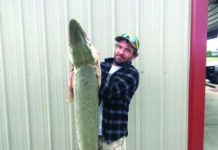Popular Moss Ball Product Poses Threat to Kansas Waters
EMPORIA – Invasive zebra mussels have been found in “moss balls,” an aquarium plant product sold through aquarium, pet and plant supply stores. Zebra mussels may be attached to or contained within the fibers of the moss balls which can then be transported and released into aquaria or other locations. Zebra mussels – a highly-destructive invasive species in North America – are classified as a prohibited species that may not be possessed alive in Kansas.
“The concern is that the adult zebra mussels or their microscopic larvae (known as veligers) may find their way into the wild, either through disposal of water through drains or dumping of aquarium contents into a waterbody,” said Chris Steffen, aquatic nuisance species coordinator for KDWPT. “Once established, zebra mussels can quickly take over a waterbody and cause significant damage, including clogging water intakes and delivery systems, disrupting the food chain, and changing the chemistry of the water which can lead to things such as blue-green algae.”
Zebra mussel-infested moss balls were first reported to U.S. Geological Survey (USGS) who alerted invasive species biologists and coordination organizations across the country. Subsequent investigation determined zebra mussel-infested moss balls have been distributed by both brick-and-mortar stores, as well as online retailers, throughout the U.S.
Consumers who have purchased moss balls or have them in aquariums are instructed to dispose of them by freezing them for at least 24 hours, placing them in boiling water for at least one minute or in diluted chlorine bleach, or submerging them in undiluted white vinegar for at least 20 minutes. Additional information on disposal can be found at: https://www.fws.gov/fisheries/ANS/zebra-mussel-disposal.html
State and federal wildlife agencies, the U.S. Department of Agriculture, and the Pet Industry Joint Advisory Council are actively working to address the issue. National alerts have gone out from the U.S. Fish & Wildlife Service, the federal Aquatic Nuisance Task Force and regional aquatic invasive species management groups. And, wholesalers, distributors, and retailers are being notified to remove contaminated products from the retail system.
ABOUT ZEBRA MUSSELS
Zebra mussels are dime-sized mollusks with striped, sharp-edged, two-part shells. They can produce huge populations in a short time and do not require a host fish to reproduce. A large female zebra mussel can produce up to 1 million eggs. Fertilized eggs then develop into microscopic veligers that are invisible to the naked eye. Veligers drift in the water for approximately two weeks before they settle out as young mussels, which grow to maturity and reproduce within a few months.
After settling, zebra mussels develop byssal threads that attach their shells to submerged hard surfaces such as rocks, piers, and flooded timber. They also attach to pipes, water intake structures, boat hulls, propellers, and submerged parts of outboard motors. As zebra mussel populations increase, they can clog intake pipes and prevent water treatment and electrical-generating plants from drawing water. In 2012, two Kansas communities, Council Grove and Osage City, experienced temporary water shortages due to zebra mussel infestations before water intake structures could be cleaned – a labor-intensive and costly process.
Zebra mussels are native to the Black and Caspian seas of western Asia and eastern Europe and were spread around the world in the ballast water of cargo ships. They were discovered in Lake St. Clair and the Detroit River in 1988 and quickly spread throughout the Great Lakes and other rivers including the Mississippi, Illinois, Ohio, Tennessee, Arkansas and Hudson. Zebra mussels were first discovered in Kansas in 2003 at El Dorado Reservoir and human-mediated dispersal has allowed them to spread to 31 other waterbodies within the state.
For more on zebra mussels and other aquatic nuisance species, visit https://ksoutdoors.com/Fishing/Aquatic-Nuisance-Species.
###





